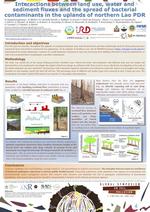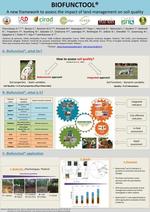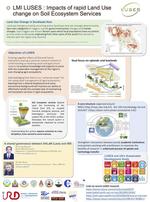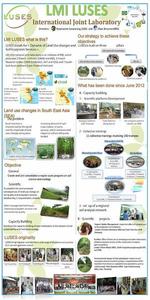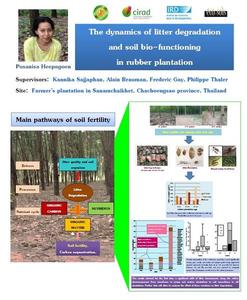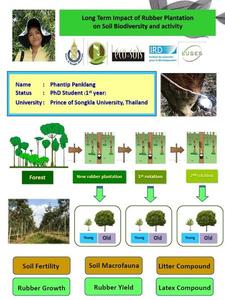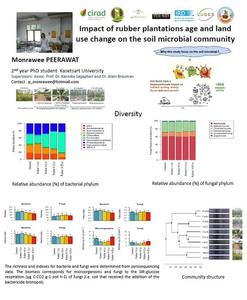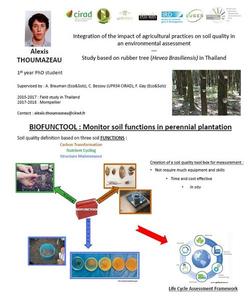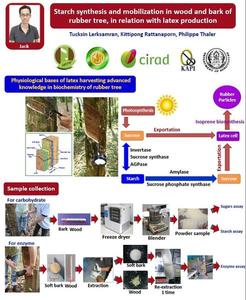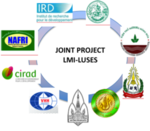BIOFUNCTOOL
HEVEAADAPT and BIODIV HEVEA
South East Asia concentrate produced more than 92 % of the world production of natural rubber. In the last decades rubber plantations replaced many farming systems as traditional subsistence agriculture or commercial crops, but also encroached into and replaced large areas of natural forests, especially in the Greater Mekong Subregion (GMS). Despite the economic and ecological importance of Rubber, studies on the influence of rubber trees plantations on the environment and more specifically on the soil biodiversity remains scarce.
Objective : Define the long-term impact of rubber tree planting activities on soil biodiversity and functions related (organic matter degradation, nutrient cycling)
To meet to 'the greater Mekong subregion countries' development
Soil degradation du to land management in Thailand is a growing issue in terms of food security (yield decrease), environmental aspects (erosion, decrease of soil diversity and organic matter) and health (water contamination by pesticides, farmer's health). Since rubber tree expansion in the last 20 years affected all the GMS area at the expense of traditional agriculture (case of Thailand) or natural forest (case of Laos), this program will help to determine the impact of this expansion on key development issue such as soil fertility, soil biodiversity and carbon sequestration.
To meet the sustatnable development goals
Objective 13: Climate change
If Industrial tree crops enter in direct competition for land with forests, the net result on climate is detrimental. However when tree planting replace annual crop this can help mitigate against climate change by removing C02 from the atmosphere. Moreover, Natural Rubber (NR) is a biopolymer and a competitor of synthetic rubber (SR) made from crude oil. 83% of the NR- 12 million tons produced every year - is made of carbon taken from the atmosphere. Our project will help to specify the impact of tree plantation on soil storage, C02 emission.
Objective 15: Life on earth
This project will determine the level of soil degradation due to rubber plantation and associated management practices. One of the main output will be to see if rubber plantation could be a solution to restore soil quality and soil biodiversity of altered soil submitted to intense agricultural practices.
Parter: LDD, KU, KKU, PSU, DP HRPP CIRAD, UMR ECO&SOLS, UMR IESS, UR 34
Contact: Alain Brauman (alain.brauman@ird.fr), Frederic Gay (CIRAD), Monrawee Peerawat (LDD), Kanika Sajaphan (KU)
biofunctool report (1.43 Mo)
Biofunctool Report
LMI LUSES Posters
Presentation of the ECOFILTER Team at the Global Symposium on Soil Pollution (GSOP18), FAO, Rome, 2-4 May 2018
Poster of the BIODIV TREE team presented at the SOM management conference held in Braunsweig on the 30 and 31 of May
Poster of the BIODIV TREE team presented at the SOM management conference held in Braunsweig on the 30 and 31 of May
Synopsis of LUSES 2017-2019
- LDD-IRD a long history of scientific cooperation
- Impact of Rubber Tree Plantation on Soil Biological Diversity
- LDD-LMI LUSES Platform of Microbiology
- LMI LUSES presentation
- PCR LDD-LMI LUSES Platform
- Laboratory guide: hygiene and safety in English
- Laboratory guide: hygiene and safety in Thai
PhDs students' scientific posters
The dynamics of litter degradation and Soil-bio functioning in Rubber plantation : Pusanisa Heepngoen
Long term impact of Rubber Plantation on Soil biodiversity and Activity: Phantip Panklang
Impact of Rubber Plantation age and Land use change on the soil microbial community : Monrawee
Integration of the impact of agricultural practices on soil quality in an environmental assessment : Alexis
Starch Synthesis and Mobilization in wood and bark of rubber tree, in relation with Latex production : Tuksin




